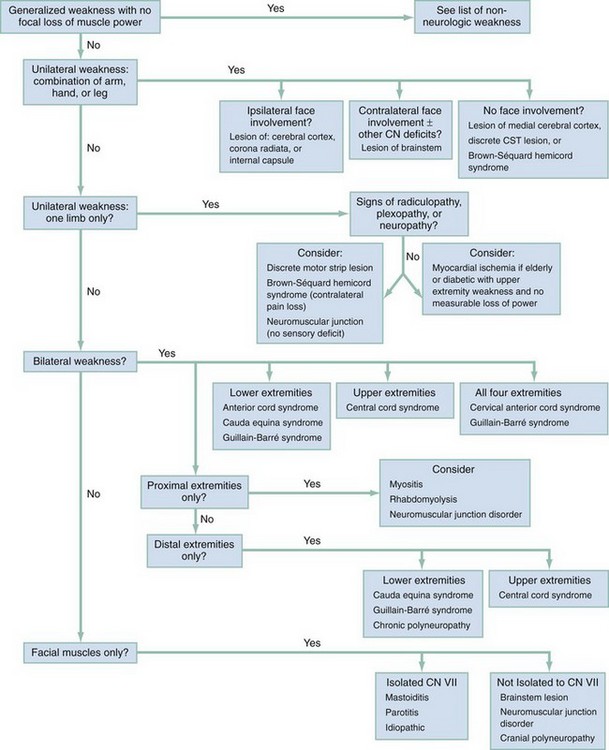Weakness
Perspective
The complaint of weakness is common in emergency department (ED) patients and may be vague, subjective, and difficult to characterize. True loss of strength from a neurologic or muscle fiber lesion must be distinguished from other systemic conditions that result in fatigue, dyspnea, or imbalance because of inadequate substrate delivery to the nervous system or muscle unit. Such conditions may be described as weakness by the patient but are likely caused by cardiovascular, pulmonary, infectious, or metabolic processes. This chapter focuses on the evaluation of acute neuromuscular weakness; it may be focal or generalized and may originate in central or peripheral nerves, the neuromuscular junction (NMJ), or myofibers themselves. Other chapters provide more detail on peripheral nerve (Chapter 107) and neuromuscular disorders (Chapter 108).
Epidemiology
The epidemiology of weakness is closely linked to the epidemiology of other diseases and medical conditions. Although weakness can be a presenting problem at all ages, patients who are elderly or chronically ill are more likely to develop weakness. Advanced diabetes, cardiovascular and pulmonary diseases, chronic infectious diseases, and cancer may produce neuromuscular weakness through secondary effects on the brain and neuromuscular system. Brain, spinal cord, peripheral nerve, and neuromuscular causes of weakness are much less common than weakness that is secondary to other medical conditions.1
Pathophysiology
There are a number of physiologic considerations for the patient with diffuse weakness (Box 13-1).
Conditions that have only peripheral effects at the NMJ and muscle have preserved reflexes.
Differential Considerations
If by history, physical examination, and bedside ancillary testing the patient does not appear to have derangements in intravascular volume or cardiopulmonary function, metabolic abnormalities, or a source of infection, the investigation turns to a neural or primary muscular cause for weakness. Often these patients will have some asymmetrical finding on their neurologic examination. The critical and emergent diagnoses for neuromuscular weakness are listed in Table 13-1.
Table 13-1
Critical and Emergent Causes of Neuromuscular Weakness
| Critical Diagnoses | |
| Cerebral cortex or subcortical | Ischemic or hemorrhagic cerebrovascular accident (CVA) |
| Brainstem | Ischemic or hemorrhagic CVA |
| Spinal cord | Ischemia, compression (disk, abscess, or hematoma) |
| Peripheral nerve | Acute demyelination (Guillain-Barré syndrome) |
| Neuromuscular junction | Myasthenic or cholinergic crisis Botulism Tick paralysis Organophosphate poisoning |
| Muscle | Rhabdomyolysis |
| Emergent Diagnoses | |
| Cerebral cortex or subcortical | Tumor, abscess, demyelination |
| Brainstem | Demyelination |
| Spinal cord | Demyelination (transverse myelitis) Compression (disk, spondylosis) |
| Peripheral nerve | Compressive plexopathy (hematoma, aneurysm) Paraneoplastic vasculitis uremia |
| Muscle | Inflammatory myositis |
Diagnostic Algorithm
Deciphering loss of muscle power means following the pattern of a patient’s weakness from the myofiber back to a particular site within the central or peripheral nervous system (Fig. 13-1). Common clinical patterns of weakness can be classified and assessed as discussed in the following sections.
Unilateral Weakness with a Combination of Arm, Hand, or Leg with Ipsilateral Facial Involvement
This presentation is generally caused by a lesion in the contralateral cerebral cortex or the CSTs coursing down the corona radiata and forming the internal capsule. Mild forms can be limited to a loss of dexterity and coordination with hand movements. Moderate loss of power is termed paresis, and complete loss of motion is termed plegia. UMN signs are useful corroborative findings but may not always be present. Sensory disturbances commonly occur over the areas of weakness. Look for associated neglect, a visual field cut, or an expressive or receptive aphasia to localize the problem to the cortex.2 Patients with equal loss of strength to the face, hand, and leg are more likely to have a subcortical lesion disrupting all of these fibers as they funnel close together in the internal capsule. Concomitant headache is suggestive of a brain hemorrhage or mass lesion.3 Sudden onset of this weakness pattern implies hemorrhage or ischemia, whereas a gradual onset may be seen in demyelination or neoplasm.




